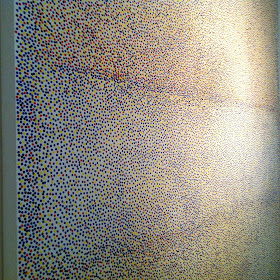Two months in Shanghai has cultivated my desire for ink: to absorb its tonalities, practice painting with it, and to see more examples of it. In the Swatch Art Peace Hotel library, I found a beautiful, hardcover catalog for the 2012 exhibition Chinese Contemporary Abstract, 1980s to Present, Pearl Lam's inaugural Hong Kong shows curated by Gao Minglu, respected for coining the term “apartment art” to describe the post-1989 turn in contemporary Chinese practice, and a seasoned curator. The works in the catalog, and catalog discussion focused on the relationship between Chinese art and modernism.
Olivier Krischer's Art Asia Pacific review of the show states that "Gao’s essay on the works and artists, available at the gallery, is titled “A Return to Humanity and the Natural World—An Introduction to Chinese ‘Abstraction’” and "presents a trusted band of artists, representing a trend he terms “maximalism” (jiduo zhuyi) referring to a group of such painters as yi pai—which... translates...more fittingly as “school of notion.” Gao... argues “abstraction” to be inherently associated with a Western current—from the Enlightenment through the industrial revolution and contemporary capitalism, via Euro-American modernism and Abstract Expresionism,...which leads Gao...to assert that “In China, traditional poetry, calligraphy and painting all advocate togetherness, not differentiation. Therefore, art is not a reflection of the outer world, but is a restoration of a shared idea.” While Krischer objects, suggesting that the works in the exhibition are as varied and diverse as each artists's travel history and methodology, discussion about the relationship between Chinese art and modernism is welcome, as artists such as deKooning are not even visible in Asia (except Pollock for the overt relationship to calligraphic line). Such a missing link, artist Feng Lialong suggests, results from ink's double capacity to express both form and line, dissolving any separation between them.
Recently, I met with Rebecca Kozlen of the gallery's Shanghai venue to view paintings in the back room. She generously shared works by the gallery's artists and their histories, below. |









































































